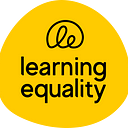Empowering teachers by enabling and preserving content-centric discussion
"All those moments will be lost in time, like tears in rain" — Roy Batty in Bladerunner, 1982
In March 2019, Learning Equality co-convened a two-day design sprint in Paris in collaboration with UNHCR, Google.org, Vodafone Foundation, and UNESCO. We explored the need for automated curriculum alignment in crisis contexts, and the possible role of artificial intelligence (AI) in recognizing curricular mandates and patterns, and recommending pertinent educational content in return. This work is part of a broader collaboration working with refugees and partner organizations to explore utilizing digital education to support learning in these contexts.
The experience of engaging our professional communities in such a challenging question was as valuable as the outputs themselves, and we want to share the discussions and debates we had as we prepare for the next sprint. Each team member that spearheaded a team project will unpack their takeaways via a blog post. The blog post series, which started with a reflection on the sprint’s metadata project, will later include the public release of our findings from this two-day sprint, shedding light on the work we can all do to ensure that the benefits of AI are able to reach learners in crisis and emergency contexts.
We’re delighted to present to you the second installment of the Design2Align series, a reflection by our co-founder and Product Lead, Richard Tibbles, on the importance of Communities of Practice and how to use tech to enable teachers to share lessons learned back across the world.
Paris, in the springtime — amongst the tumult of a Design Sprint focused on curriculum alignment using AI, a plucky team of teachers, trainers, designers, and OER advocates banded together to focus on supporting teachers to grow, and leveraging their expertise to support automatic enhancement and discovery of curriculum.
Teachers learn best from experience, and from each other. Communities of practice are an important opportunity for teachers to continue to refine their teaching, reflect, and learn valuable insights from colleagues and mentors — whether through discussing their own practice, or hearing about the practice of others.
Teachers in low-resource/disconnected environments who want to improve their content-specific pedagogy and general teaching practice, can frequently be cut off from these opportunities. In such environments, teachers may have limited numbers of peers with which to interact, especially for those who are subject specialists.
Standard models of teacher development and continual professional development are best delivered through communities of practice, because they allow for engagement in discussions with other teachers, and learning from their experience, in order to improve the quality of lessons for their students. In an entirely in-person scenario, a community of practice might follow the following storyboard:
During the reflection phase, teachers generate discussion and ideas around teaching practice, both in terms of using specific resources for teaching, and on how to diagnose/correct misconceptions, help students understand skills and concepts from different perspectives, and push students’ understanding to higher levels of Bloom’s taxonomy.
Ordinarily, all this discussion is ephemeral, shared only with the direct community of practice. However, to fully leverage these conversations and make the lessons learned from them scalable and amenable for access to those in low-resource/disconnected scenarios, we propose a system to help capture and preserve these discussions, in order to share lessons learned from across teachers, potentially across the world.
By designing systems that scaffold, facilitate, and capture these reflections and discussions, we give teachers valuable opportunities and prompts to reflect on their teaching. By giving them an authentic audience of peers with whom they are sharing their reflections, through the capturing of these discussions, teachers are incentivized and encouraged to share their understanding and ideas.
As well as creating a valuable contextualized resource for teachers, these teacher annotations become a valuable additional data set to analyze alongside the resources that prompted the discussion and reflection, allowing more nuanced and detailed models to target resources to curator, teacher, and student needs.
By considering and serving the professional needs of teachers, we also serve the needs of the broader community of Open Educational Resource users — generating metadata and guidance that can help with the effective and aligned use of resources in many different contexts.
Going forward, a prototypical system will be implemented, with the following key features: platform-agnostic, threaded/contained discussion, upvotes/liking, top recommendations, and most importantly offline discussion caching/archiving. In addition, there are many outstanding questions that demand further exploration. What should the core question/recommendation set be that will best elicit useful feedback from teachers, and also guide their professional development? How much and in what way should we allow users who generate annotations to be exposed to other users — building their own reputation as a master teacher is important, but may also make people more reluctant to share.
Finally, how can we leverage machine learning to make smart recommendations about which annotations from which contexts are most relevant to a particular teacher? There is still a lot of work ahead, and we are looking forward to the next step in the process when we move from ideas to execution!
The Design2Align blog post series will continue with a discussion about the process of digitizing educational standards so that learning materials can be reusable across countries. This topic will, in fact, be the focus of a hackathon-type event we are organizing in collaboration with UNHCR and the support of Google.org. The hackathon will take place in San Francisco on October 16–18, 2019. If you have experience with machine learning, artificial intelligence, data science, or natural language processing and are interested in being involved, please be in touch as space is limited. Follow the hashtag #design2align for links to demos and datasets that will be produced during the event.

